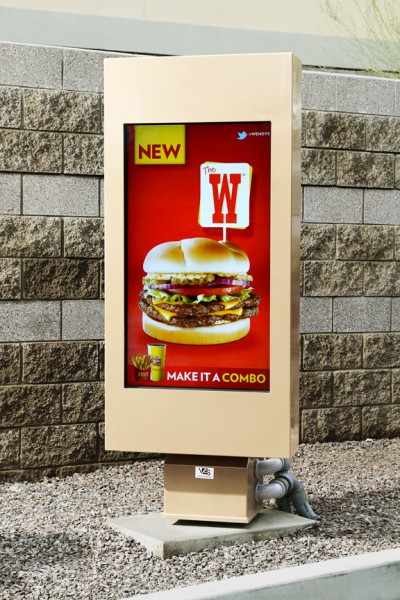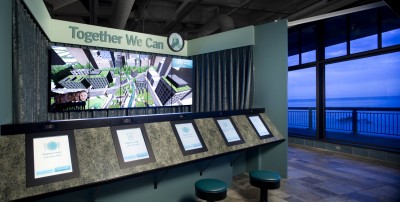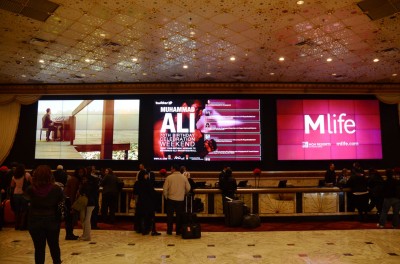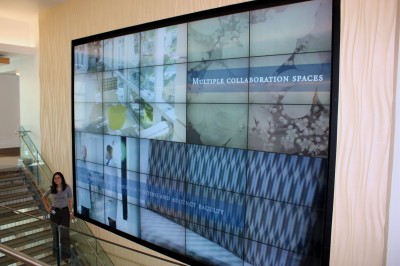Current and future display technologies
by all | 11 February 2014 8:30 am
 [1]
[1]Photos courtesy NEC Display Solutions
By Rich Ventura
At the International Consumer Electronics Show (CES) in early 2012 in Las Vegas, Nev., the talk of the show floor—and the media—was the unveiling of new organic light-emitting diode (OLED) TV screens from a variety of manufacturers. Crowds of attendees were captivated by the narrow profile and visual clarity of these displays. The OLED screens were so thin, in fact, it became evident TVs will soon become not merely add-on appliances, but instead fully integrated components of people’s homes.
The advent of such technology brings to mind the nature of the digital signage industry, the degree to which it has evolved and where it is heading next. Different display technologies have played important roles in the growth of digital signage as a medium over the years.
In the earliest days of digital signage, organizations would simply install a standard cathode ray tube (CRT) TV and hook up a video feed to display advertising, event announcements, news, weather reports and other forms of content for their target audience. In some instances, merchants used a Video Home System (VHS) tape to provide this feed and market to their clientele.
As is the case today, digital signage back then was driven by users’ goals, purposeful content and practical applications. The bulky and heavy displays themselves, however, were not optimal for the commercial market, especially for businesses that required their systems to operate 24-7. With other advances on the horizon, it was clear CRTs would not fit the bill for long.
A handful of technologies soon took over the marketplace, including light-emitting diode (LED) arrays, plasma screens and thin film transistor (TFT) liquid crystal displays (LCDs). The latter two technologies, especially, captured most of the commercial display market, with their narrower designs introducing greater versatility than had previously been possible with CRTs.
 [2]
[2]Today’s professional-grade LCDs typically provide higher brightness than plasma displays.
Plasma screens
The size of plasma displays increased dramatically over the years. The first 1.1- and 1.3-m (42- and 50-in.) models were introduced in 1997. Further developments culminated in the debut of a 3.8-m (150-in.) plasma screen in 2008.
Plasma represented a very durable and high-performing technology, but compared to other display types, it used more energy and was less viable around-the-clock, as customers had to deal with issues of image burn-in. Today, while plasma still has a place within the digital signage market and some manufacturers continue to provide it, it is generally considered a relatively outdated technology.
LCDs
Large-format LCDs arrived later than plasma screens of the same size; the first 1-m (40-in.) LCD models, for example, shipped in 2003.
Today’s professional-grade LCDs typically provide higher brightness levels than plasma displays and are considered a ‘greener’ technology due to lower energy consumption.
Nonetheless, they are not perfect. Compared to plasma, they offer lower contrast levels, due to their transmissive technology and comparatively limited viewing angles.
Video walls
Technology continues to provide innovative ideas and designs for the large-format digital signage industry. New ultra-narrow bezels, for example, are driving the adoption of larger video wall systems in public spaces, by allowing standard 1.2-m (46-in.) or larger LCDs to be ‘tiled’ into one massive display.
In turn, this is affecting the digital projection market, too. Instead of large retail venues using high-brightness projectors to display images on blank spaces, they are looking to build video walls.
 [3]
[3]Video walls were too expensive a few years ago for many of the same venues that are implementing them today.
Less than a decade ago, video walls were too expensive for most retailers, restaurant owners and other venue managers to justify implementing. Now these same vertical markets are deploying video walls throughout many locations. The investment has not only become more cost-beneficial, but also given them more of what they want, with the narrower bezels meaning less visual interruption of the displayed images.
Further, video walls lend themselves to be used not simply for retailers’ signage applications, but also for atmospheric purposes. One outdoor recreation store, by way of example, has installed a video wall so the interior décor can be revamped at a whim, rather than having to pay repeatedly to paint and repaint the building’s walls and/or tear down and move merchandising fixtures back and forth. So, adopting this strategy potentially represents huge cost savings for the retailer.
LED-backlit LCDs
In the past, LCDs have typically used cold-cathode fluorescent lamps (CCFLs) for backlighting. A more recent technological has been the introduction of LED-backlit LCDs, which are generally thinner in terms of depth. While they are simply LCDs with a different backlighting configuration, these are now becoming increasingly popular. They are not a mature technology and have not yet achieved the same level of market saturation as CCFLs.
Indeed, the market potential for LED-backlit LCDs remains debatable, but if the technology can deliver on its promise of lower power consumption, longer lifespan and better contrast ratio, it will have significant benefits for users and there is a good chance it will become the predominate technology in the market in the years to come.
So far, market research supports this assessment. According to consulting firm DisplaySearch’s Quarterly Large-Area TFT LCD Shipment Report, 100 per cent of the commercial displays sold through channel sales in the first quarter of 2010 used CCFL backlighting, but by the fourth quarter of 2011, 16 percent of units sold used LED backlighting.
 [4]
[4]LED-backlit LCDs promise lower power consumption, longer lifespan and better contrast ratio.
Meanwhile, market research firm iSuppli’s Worldwide Signage & Professional Displays Q4 2011 Market Tracker illustrated customers’ growing interest in video walls. The report estimated the North American market for LED-backlit video walls would increase by 18 percent in 2012 and then nearly double by 2015, seeing solid double-digit growth year-over-year. The retail and outdoor segments were expected to be the heaviest investors in LED backlighting technology this year.
Touch screens
Another factor driving the market is the desire for interactivity, which is leading to the greater popularity of touch screens. With the ubiquity of smart phones, e-readers and tablet computers, many retail and restaurant customers are already used to interacting with on-screen content via the screen itself, instead of a keyboard and/or mouse.
For younger generations, especially, technology interfaces occur almost exclusively through touch screens. In fact, children will touch almost any LCD, expecting it to react accordingly.
People want to touch displays, so retailers, hoteliers, airport directors and other managers of public-facing venues have all started to use digital signage that integrates interactive features. The industry is preparing for this trend to become even more widespread in the future.
 [5]
[5]New ultra-narrow bezels are helping increase the adoption of larger video wall configurations.
OLED displays
As mentioned earlier, the OLED TVs at this year’s CES made a strong impression on attendees. Many in the wide-format display industry may wonder how this technology could affect the digital signage market.
This type of screen is a printed display that does not use backlighting, but instead is operated by electric impulses that activate the OLEDs. This technology means the screen can be thinner and lighter, consume less power, provide deeper blacks and emit less light per square inch than an LCD.
While OLED technology will therefore be a definite game-changer for the industry, it is currently very expensive and has little past performance to measure. So, it will still take years to establish the full role OLEDs will play in the digital signage industry, just as it took time for LED backlighting to be tested by the rigorous demands of commercial digital signage networks before it could build a strong foothold in the market. Until then, LCDs will remain the ‘workhorse’ of the industry and LED-backlit models will continue to add market share.
Rich Ventura is director of vertical market sales for NEC Display Solutions. For more information, contact him via e-mail at rventura@necdisplay.com[6] or visit www.necdisplay.com[7].
- [Image]: http://www.signmedia.ca/wp-content/uploads/2014/02/Plasma_Grocery-Store.jpg
- [Image]: http://www.signmedia.ca/wp-content/uploads/2014/02/high-bright_Wendys.jpg
- [Image]: http://www.signmedia.ca/wp-content/uploads/2014/02/MontereyBayAquarium.jpg
- [Image]: http://www.signmedia.ca/wp-content/uploads/2014/02/LED-Backlit_MGM.jpg
- [Image]: http://www.signmedia.ca/wp-content/uploads/2014/02/Ultra-Narrow-2.jpg
- rventura@necdisplay.com: mailto:%20rventura@necdisplay.com
- www.necdisplay.com: http://www.necdisplay.com
Source URL: https://www.signmedia.ca/current-and-future-display-technologies/